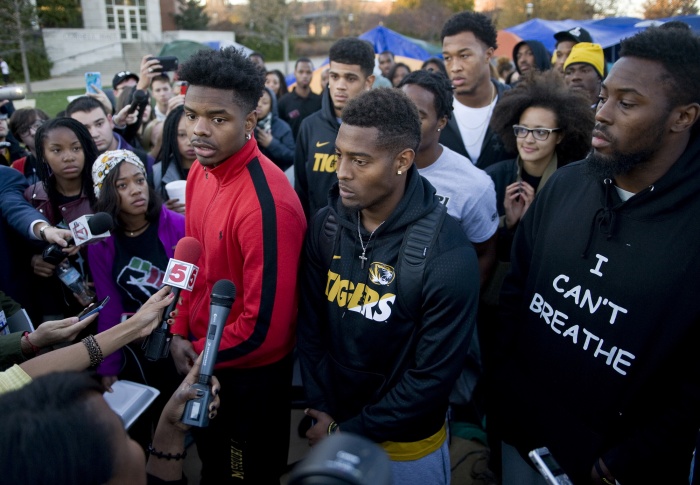Following weeks of protests over racial tensions at the University of Missouri, dozens of members of the school’s football team announced that they would not practice or play in any games until members of the university administration resigned. Within days, the president of the multi-campus university system stepped down, and the chancellor of the main campus in Columbia promised to step down to a less prominent role. The disturbing issues that players were protesting included multiple specific incidents of racism targeted at black students, but also the overall lack of action from the administration to address the racially charged atmosphere on campuses.
The Missouri football team’s protest is the largest and most high-profile example of college athletes using their status and visibility to effect change in non-sport related issues they care about. The notion that an entire team in the most dominant college football league in the United States could go on strike drew national attention to the plight of black students at the University of Missouri. Critics will point to the fact that the administration’s immediate response was due solely to the financial impact that the football team has—generating $35.64 million for the school in 2014—and the million dollar fine that Mizzou would have incurred had they missed their upcoming match-up against Brigham Young University.
But it goes deeper than that. The football team’s threatened strike proved that student-athletes have a unique visibility and potential for leadership as activists at all universities. Members of collegiate sports teams—whether recruited or not, and whether their programs generate millions of dollars or not—are still representatives of their schools and have a platform to be leaders and role models for their fellow students, especially in the social media age.
“We just wanted to use our platform to take a stance as fellow concerned students on an issue," University of Missouri defensive back Ian Simon told the New York Times. "We love the game, but at the end of the day, it is just that—a game."
At McGill, a school already known for its activist student body, athletes still have the ability to lead social movements. Events such as McGill Athletics’ Movember challenge, and the many fundraisers that various teams put on are a starting point, and demonstrate that the Redmen and Martlets have a desire to use their unique voices to make a difference.
“Being a student athlete shows amazing dedication and a different position within the school,” said senior MArtlet swimmer Katie Caldwell. “we should take a responsibility to make a change where possible.”
History is full of examples of athletes stepping up and taking stands on social issues that they believe in. One of the best-known images in sports is of San Jose State sprinters Tommie Smith and John Carlos standing on the 1986 Olympic victory podium. They had their right arms raised high in the air and their fists clenched in black power salutes. NBA Hall-of-Famer Kareem Abdul-Jabbar was well known to have joined student protests at UCLA while a student-athlete there in the late ’60s.
"Let this be a testament to all of the athletes across the country that you do have power," Mizzou defensive end Charles Harris said during the team’s protest. And he’s right. When players make it clear that they care about an issue, other voices will follow.









